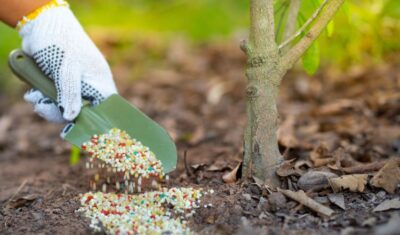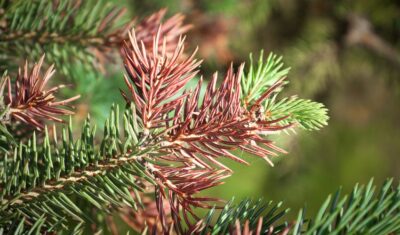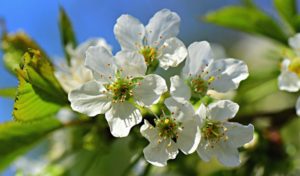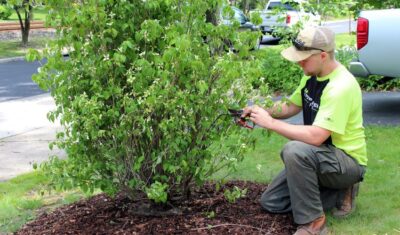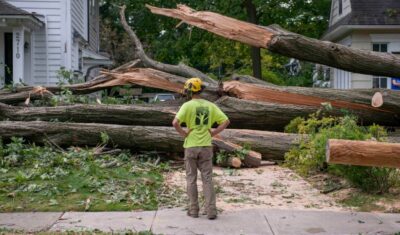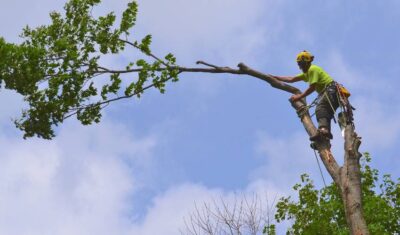Do trees in your yard need to be fertilized? What kind of fertilization is best for trees and shrubs? What happens if trees aren’t fertilized? When is the best time of year to apply fertilizer to trees in northeast Ohio? How should you do it?
Keep reading for answers to those questions about fertilizing trees – and many more!
Do trees in your yard need to be fertilized?
If you have trees, chances are you need to fertilize them. Trees that grow in forests and woodlands get their nutrients from the soil they grow in, but the soil in urban and suburban areas is nothing like native soils. Here’s how it’s different:
Soil is Compacted
Tree roots struggle to grow in compacted soil because they can’t penetrate the heavy material. Water either runs off compacted soil or collects and doesn’t drain.
It’s Really Subsoil, Not Topsoil
When developers build urban and suburban areas, they may use the subsoil from excavation as landscape soil. Unlike topsoil, this subsoil has few to no nutrients in it and can’t support healthy tree and plant growth.
Soil is Depleted
In undisturbed forests, fallen leaves, twigs, and fruit collect on the ground. All this nutrient-rich organic matter breaks down into the soil for tree roots to use. Sadly, in urban areas, this is all raked up and thrown away.
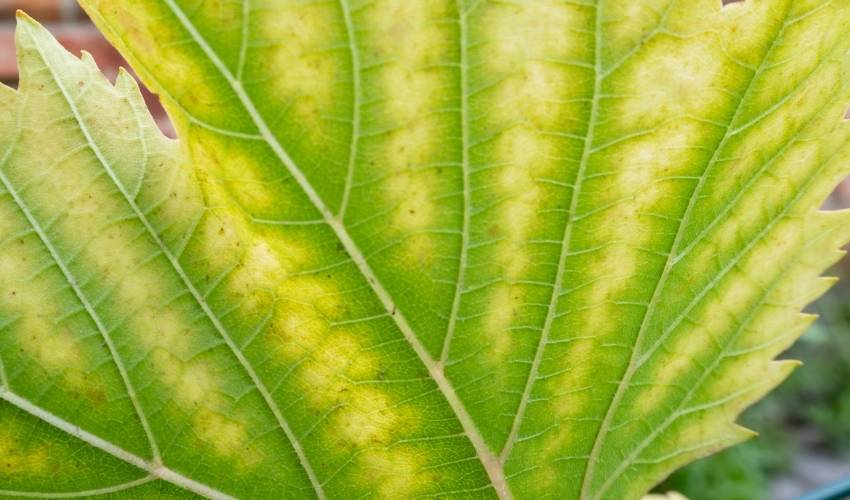
Leaves turn yellow between the veins when lacking in specific nutrients. This process, called chlorosis, can be prevented with healthy soil and good plant nutrition.
What’s the difference between fertilization and soil amendment?
We use tree and shrub fertilizers to help trees stay healthy in urban soils. We use soil amendments for long-term soil improvement. Though they provide similar end results, the two things are different.
Soil Amendments
Compost and other soil conditioners contain well-decayed organic matter, such as green waste and animal manure. When you add this to your soil, it improves the soil’s long-term structure, fertility, and water-holding ability.
Fertilizers
Fertilizers are fast-acting nutrient sources that may be liquid, granular, or slow-release pellets. The nutrients in these fertilizers dissolve in water and tree roots take them up for the tree to use.
Both fertilizing and improving soil health through amendments are key parts of your garden health care plan.
What’s the difference between synthetic and organic fertilizers?
Many fertilizers are called “synthetic” because they’re created or synthesized from inorganic, chemical sources. This is different from an “organic” soil amendment or fertilizer made from organic matter, meaning things that were once alive (for example, leaves, wood, animal manure). Synthetic fertilizers generally work more quickly than organic but don’t have the long-term benefits for soil or plant health.
How can I tell if my trees need to be fertilized?
When your trees are lacking the nutrients they need, they struggle to grow. You’ll see several symptoms, including:
- Stunted growth – When a tree can’t get all the nutrients it needs, it will slow its growth to conserve energy.
- Thin or patchy foliage – If a tree is lacking nutrients, it will cut off resources to twigs and branches to conserve energy.
- Yellow leaves – Nutrient deficiency shows up in a tree’s leaves, making them yellow instead of healthy green.
- Dropped leaves – Your tree may drop leaves during the growing season when it doesn’t have enough nutrients and food energy to support them.
- Insects and diseases – A stressed tree has fewer natural defenses and is more susceptible to attacks from insect pests and diseases.
What happens to trees that aren’t fertilized?
Your tree will keep trying to grow even when it’s lacking vital nutrients, but its long-term health won’t be good. The combination of stunted growth and chronic nutrient stress during growing seasons will shorten its lifespan significantly.
Many homeowners compound the problem by mistaking the signs of nutrient deficiency for water stress and overwatering the tree. Or they over-prune thinking this will stimulate more growth (it won’t).
Should I fertilize a newly planted tree?
A young tree comes with a small store of food energy that it needs to conserve, and a small rootball that must supply all the water and nutrients the tree needs. Your new tree may need some extra fertilizer to help until it can grow more leaves and more roots.
Be sure that you don’t overfertilize your new tree!
Planting or transplanting is stressful for a tree, and it needs some time to recover. Too much fertilizer will stimulate more growth than a young tree can support.
Which type of fertilizer should I use for trees and shrubs?
If you’re not sure about what kind of fertilizer your trees need, don’t guess. You could be doing more harm than you think. Both the wrong kind of fertilizer and the wrong amount will have negative effects.
Different types of trees and shrubs have different needs. If you want more fruit, for example, you don’t give your fruit tree lots of nitrogen, as nitrogen stimulates green leaf growth, not fruit growth.
Likewise, potassium fertilizer won’t help yellowing leaves as it encourages fruit development.
The ratio of nutrients on a fertilizer label can be confusing but if you’re a DIYer it’s worth your time to learn the basics.
Is it possible to use too much fertilizer?
In northern Ohio, over fertilization is a serious problem and one you don’t want to add to.
If you’re a homeowner buying packaged fertilizer, follow the instructions on the label. More is not better!
Signs of Over Fertilization
When you give your tree too much fertilizer, you’ll see several symptoms, including:
- Brown leaf edges or leaf tips
- Yellow, limp leaves
- Leaf drop
To a homeowner, these symptoms can look just like signs of nutrient deficiency! Instead of guessing, ask a professional for help.
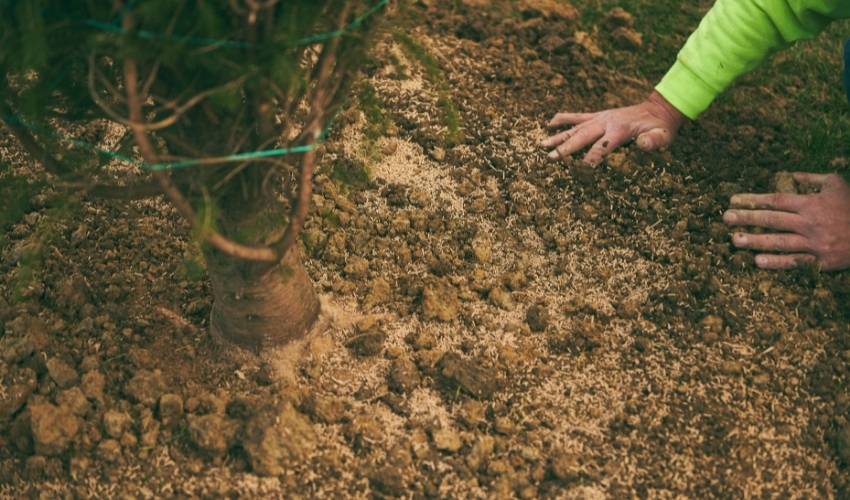
Newly planted trees often benefit from the addition of a slow-release, organic fertilizer that will improve soil conditions over time.
When should I fertilize my trees?
In northeast Ohio, spring and fall are the best times for tree fertilization.
Benefits of Spring Fertilization
When you fertilize your trees in spring, you’re giving them a hand after a long, cold winter. If you’ve had your trees pruned during winter or if they’ve suffered damage from winter storms, in spring they will start using their limited energy stores right away to seal off wounds.
Spring fertilizing helps ensure your trees have enough nutrients for maximum leaf and flower growth. This means you’ll have vigorous trees that will give you summer shade and healthy crops of fruit.
Benefits of Fall Fertilization
After a long growing season, your trees start to wind down their activity in fall. Fertilizing your trees in fall will help them build up their energy stores to carry them through winter. (You won’t see any growth above ground during winter, but tree roots never sleep!).
PRO TIP: In fall, you don’t want to fertilize your trees or shrubs with nutrients that stimulate leaf growth. Any new growth a tree puts out in the fall will die right after the first freeze, and you and your tree have wasted the benefits of fertilization.
Does it really matter what time of year you fertilize a tree?
The key to fertilization is timing. For example, adding nitrogen to your trees in winter will do nothing because:
- Trees are dormant and not producing leaves, and
- Frozen ground means water-soluble fertilizer won’t reach tree roots.
Your trees and shrubs need fertilizer at certain points in their annual growth cycles; at other times the fertilizer will be wasted. The best time to fertilize your trees is right when they need it.
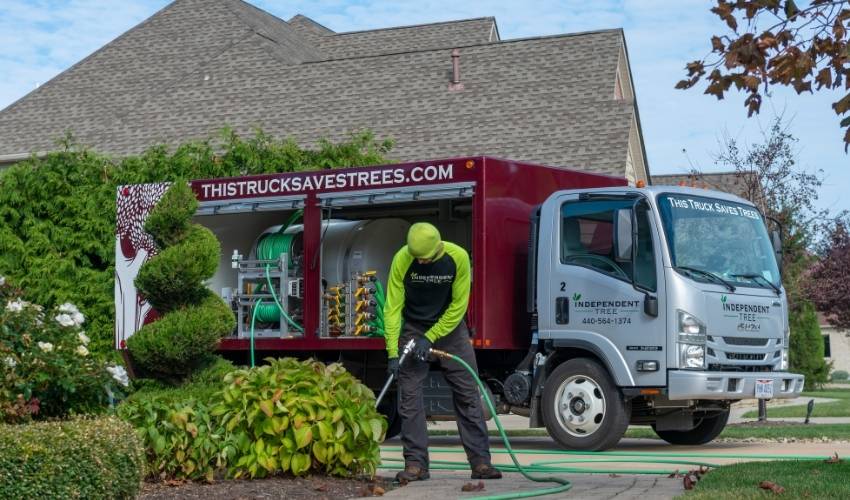
Deep root fertilization requires special equipment but it well worth it when you see the results of getting fertilizer directly to the roots where plants can take it up more quickly.
What is the best way to fertilize my trees?
The best kind of fertilizer is the one that gets the nutrients your tree needs right to its roots, when it needs it. And that’s deep root fertilization.
With deep-root fertilization injections, nutrients go down into the soil to the depth where tree and shrub roots are growing. The liquid fertilizer is ready to go and can be taken up by roots right away. This means there’s no waste and no surface runoff.
And deep-root fertilization provides another benefit at the same time: it aerates your soil. More oxygen in your soil means healthier soil!
This type of fertilization is a job for a trained professional and we don’t advise homeowners to try it themselves. Your tree’s roots are its lifeline, and it’s not worth risking damage to them.
Deep-root fertilization versus surface fertilizing
| Deep-root fertilizer already mixed in liquid | Granular fertilizer needs to be scratched into soil |
| Deep-root fertilizer goes right to tree roots | Surface fertilizer needs watering in; excess will run off |
| Deep-root fertilizer aerates soil | Surface fertilizer does not |
What if I can’t fertilize my trees myself?
If you don’t have enough time or if you don’t feel confident fertilizing yourself, give us a call!
Need a Hand?
We’re experts in soil improvement and tree nutrition and can advise you on the right type of fertilizer and the best time to fertilize the trees you have.You can also take advantage of our Plant Health Care program to be sure that you’re giving your garden everything it needs now, and all year round.
Recent Articles
Topics
About The Author

STAY IN THE LOOP
WITH OUR
LATEST UPDATES
"*" indicates required fields

